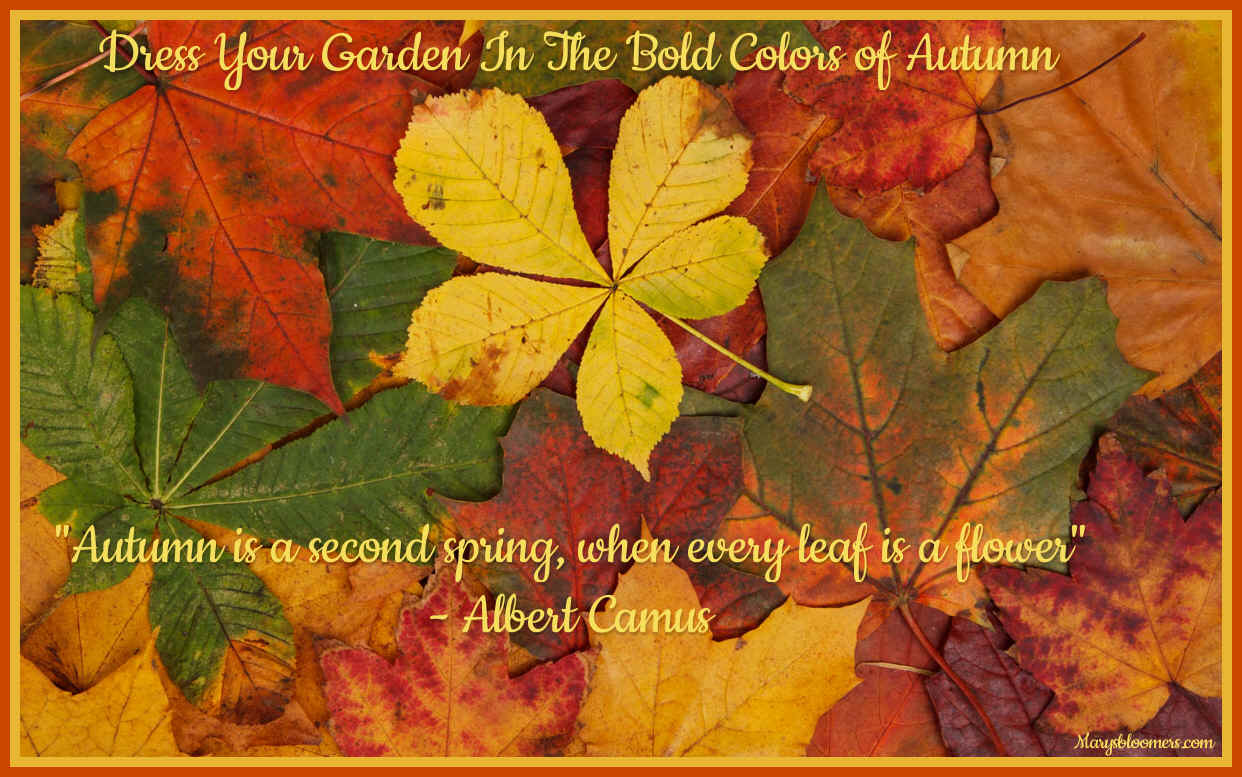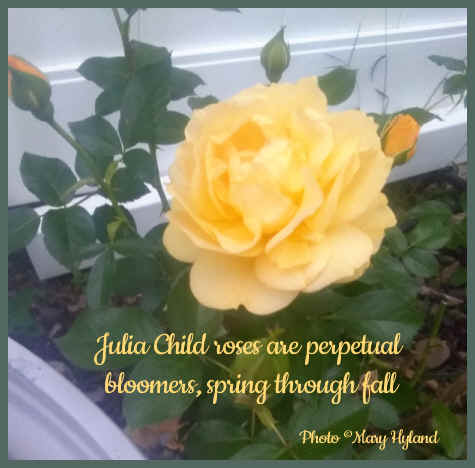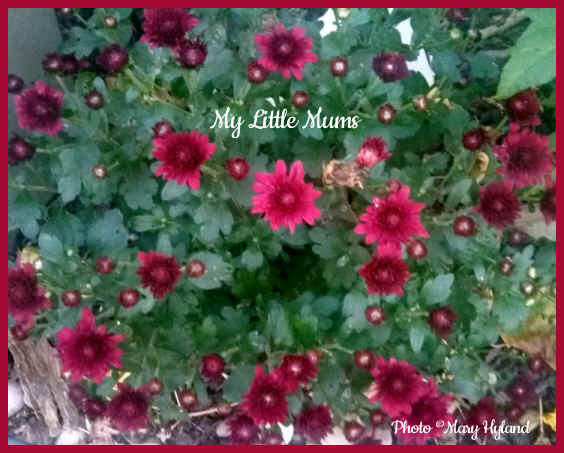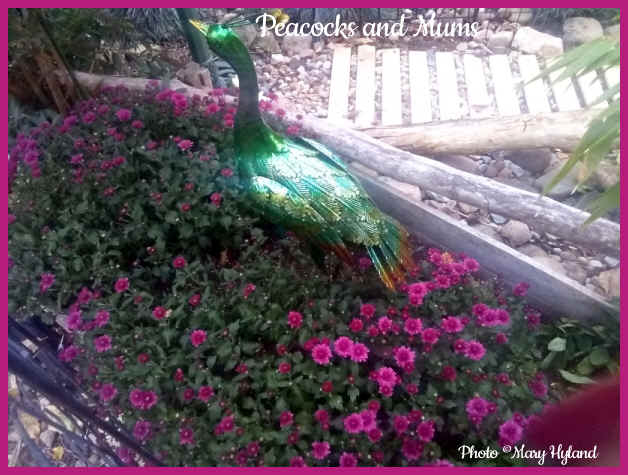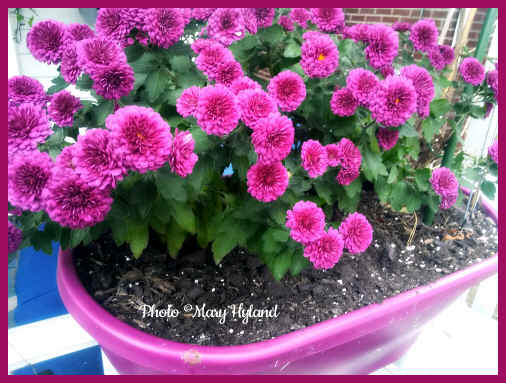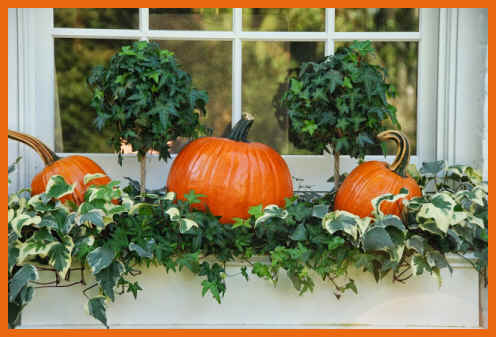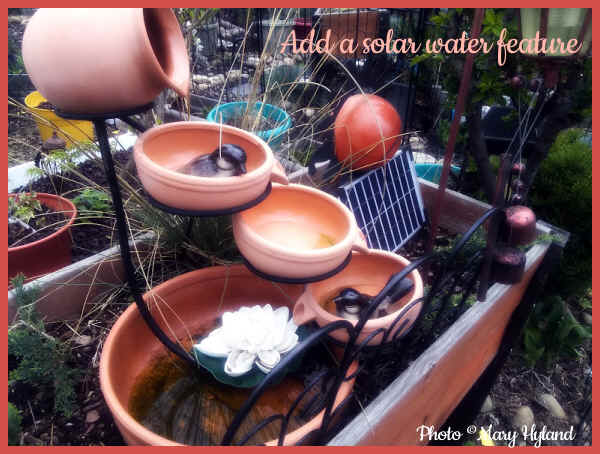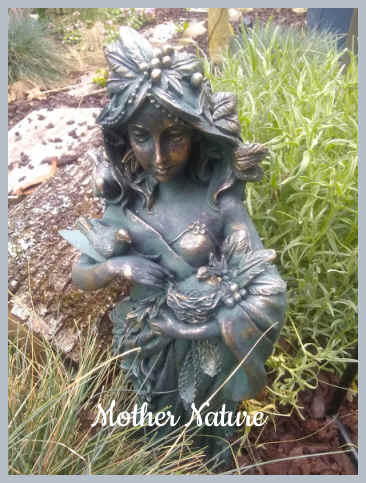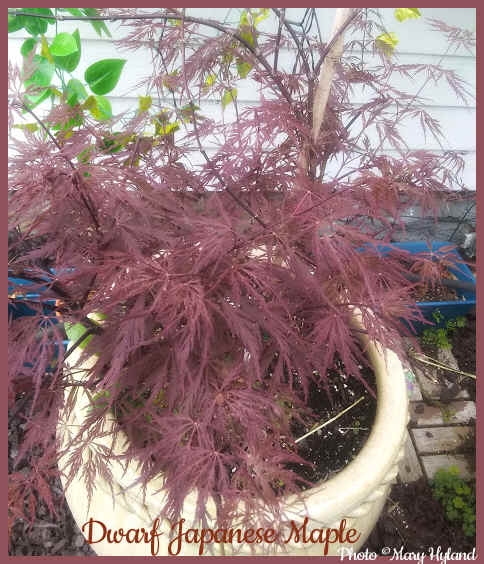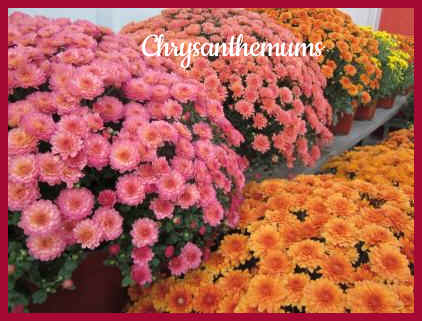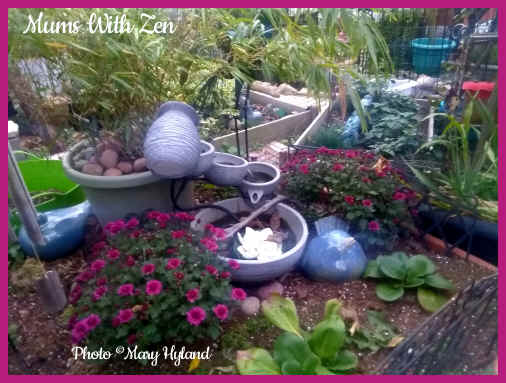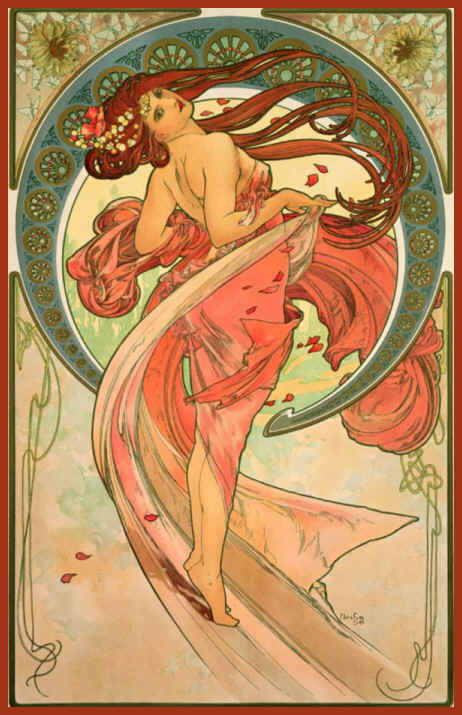|
Autumn has a
distinctive feel. I'm affected by the change of seasons, but not as much
as the ending of summer and the beginning of the holidays, just before
The Big Sleep.
Think of how it feels
to take a weekend drive through the countryside in fall, and how
impossible it seems that flowers, plants and trees can come in so many
colors and shades for the fall palette. It looks like Mother Nature has
set the world on fire with a riot of incredibly powerful shots of color,
fragrances in the air that belong only to autumn, and that distinctive
feel of plants and animals getting ready for a season of slumber.
Complete with a thick carpet of color beneath them.
You knew when spring
came, because you just about burst into song the day of the last freeze
because the Cabin Fever broke. You knew when summer was past, and a new
season of holidays and indoor gatherings has come. It has a totally
different feel. Fall is like Mother Nature's consolation prize for
taking summer and the outdoors away from you for a while. The colors are
hot and bold, and continuously changing until the leaves drop.
If autumn color is what
you want, as well as spring and summer beauty, it will take a bit of
advance homework, but it's easily do-able. And you can start doing it in spring
and summer. I used to place straw bales from the farm around and in the
backyard garden at the beginning of September. Use these to set pots of mums,
interesting bare branches and pumpkins in and on, or sit one of your
ornamental garden folk on top. I also used bushel baskets and pint
baskets I got from area farms and flea markets in arranging my
scenery.
There are so many
possibilities. Just concentrate on the colors and large assortment of
flowers and fruits in their natural fall attire. If you have the room in
an unused area of the summer garden, you might want to grow some of the
funky gourds and small pumpkins in unusual colors so that you can
decorate the main area of your garden after they're picked. After the
season, many types of gourds can be dried and kept for ornamental
purposes, or dry and craft into hanging bird houses. Some are the gourds
used to make maracas (my favorite). I had several gourd birdhouses, and
they were used by many bird families.
Some
tall and not-very-average perennial plants to consider trying to add to
an Autumn Garden.
They're native plants and bloom for a while. I prefer smaller varieties
of fall flowers that
grow in neat and colorful mounds, and a few tall varieties in the back
of the beds.
If
you have room around your summer flowers, plant them in-ground. Or just
create a potted Autumn Flower Garden
to add when the summer flowers are done for the season. Potted
perennials can be left outside in their pots, if the pot is large
enough.
(do not use clay pots if leaving outside all winter. They will surely
crack once water soaks in, freezes, and expands, unless wrapped).
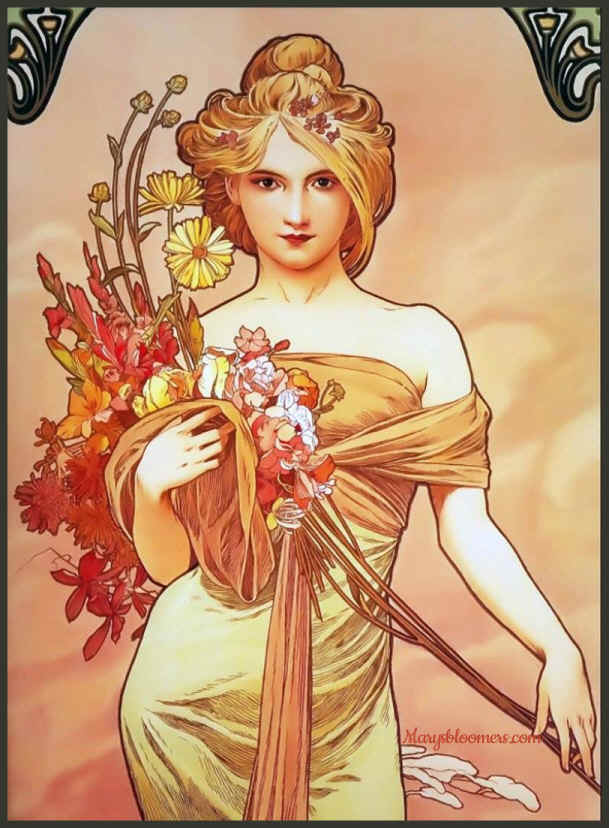
Helenium
Part of a big group of native plants in the daisy
family, helenium offers cheery yellow, orange, or red
blooms at the end of the season. And despite its common
name of sneezeweed, it won't aggravate your allergies.
It is so named because the flowers were made into snuff
in the past, used to induce sneezing to clear out
congestion.
Name: Helenium autumnale
Growing Conditions: Full sun and
well-drained soil
Size: To 5 feet tall
Zones: 3-8
Turtlehead
A fun plant with a fun name, turtlehead earned its
name because of the shape of its purplish-pink
blooms. Clusters of these unique flowers appear around
August and keep going until freezing weather sets in.
This perennial likes damp soil, so it makes a good
choice near water gardens or in bog gardens.
Name: Chelone lyonii
Growing Conditions: Part shade and
consistently moist soil
Size: To 3 feet tall
Zones: 4-9
Tall Asters
Asters of all types bear tons of pink, blue,
purple, or white flowers that are gorgeous in a vase
or in the garden. Butterflies and many other
pollinators flock to these flowers. This is a very
tall variety for the back of a border or as an edging
along fences.
Name: Symphyotrichum novae-angliae
Growing Conditions: Full sun and
well-drained soil
Size: To 6 feet tall
Zones: 4-8
|
|
Goldenrod
Contrary to popular belief, goldenrod is not a source of
seasonal allergies (ragweed, which blooms at the same time, is
the allergen).
Name: Solidago rugosa
Growing Conditions: Full sun and
well-drained soil
Size: To 4 feet tall
Zones: 4-9
Perennial Sunflower
While most gardeners are familiar with the big-blooming
annual sunflowers, perennial species are every bit as
beautiful. 'Lemon Queen' produces beautiful creamy-yellow
blooms in late summer and early fall. So does Mexican
Sunflower.
Instant sunflowers: If you feed sunflower seed mixes to
your birds, you know they are constantly dropping seed, and
that the seed will grow into plants if you don't pull them
out.
I make a habit of leaving a few to grow into the fall. None
of them are as tall as the typical sunflower plant. They are
the basic shorter sunflower, but very pretty. The look nice
among the taller perennial varieties as filler. The dried seed
heads will be a source of free bird food, and the plant will
die in the winter. Leave the seed heads on for a time if the
birds don't devour them right away.
Name: Helianthus maximiliani.
perennial
Growing Conditions: Full sun and
well-drained soil
Size: To 8 feet tall
Zones: 4-9
Mexican
Bush Sage
Dozens of plants in the sage family are native to North
America, and Mexican bush sage is one of the showier ones you
can grow. It has downy, white stems, gray-green willowy
leaves, and spikes of pinkish purple flowers that attract
hummingbirds. It's perennial in the warmer regions of the U.S.
but can be grown as an annual in colder areas where it isn't
hardy.
Name: Salvia leucantha
Growing Conditions: Full sun and
well-drained soil
Size: To 4 feet tall
Zones 8-10
Anise
Hyssop
This tough, drought-tolerant perennial looks beautiful for
months in summer and fall. That's when anise hyssop is covered
with spikes of lavender-blue, licorice-scented flowers that
pollinators love. It's also known as hummingbird mint because
this mint family relative draws plenty of these winged
visitors.
Note: Whenever I see "Mint family" in
any plant suggestion, I warn you -- grow them in p0ts no
matter how beautiful. I have found all plants in the mint
family to be aggressively invasive when not contained. You
will NEVER rid your garden of culinary mints, and I'm sure
it's the same for any mint. It had defied pulling and moving,
20% acid vinegar baths, bleach, and even asphalt and cement
barriers in my driveway. I am sure their running roots
traveled an acre underground. They're all very pretty and
valuable culinary herbs, but do not plant them in the ground
unless you are growing a meadow or open field. Your
neighbors will hate you. Whatever you grow them next to will
be smothered and run over. Give them their own pots and do not
let them reproduce.
Name: Agastache foeniculum
Growing Conditions: Full sun and
well-drained soil
Size: To 5 feet tall
Zones: 4-9
Giant Hibiscus
Another beautiful, tall plant to grow is the Giant
Hibiscus, hardy in the north (I grow them in zone 6). Cousin
of Rose of Sharon, It grows on very tall stems and covers
itself with 10-12 inch blooms along fences and in the backs of
rows from July til frost. They will return year after year.
That can be the first-blooming plant in your Autumn garden.
They are available in white and reds to blend with the fall
colors, as well as the customary pinks.
They will need to be staked and sometimes tied. Mine grow
to 6-7 ft. along my fence line. They die down to the ground in late fall, and begin
growing again in June. Do not make the mistake of planting
Tropical Hibiscus - they are not all hardy. I learned that
lesson the hard way.
Full sun, part shade. Zero maintenance.
|
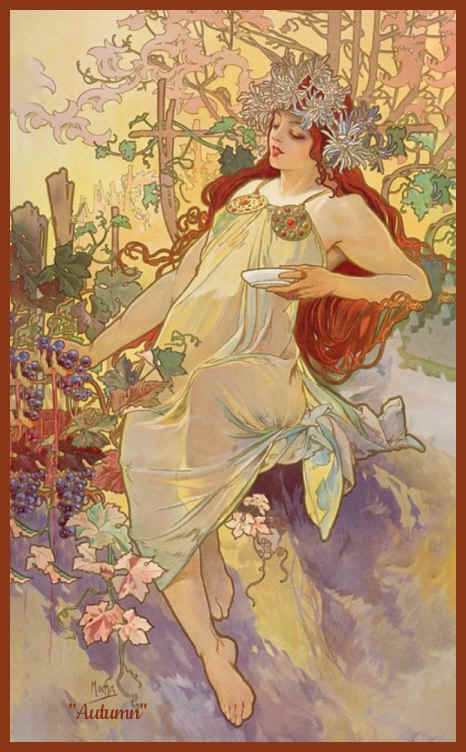
For the year-round and four
season garden, choose plants with long (until after frost) bloom
times, in yellows, oranges and reds for the transition into
fall. Choose foliage plants that turn a bright range of autumn
colors and late season shades of green. They take up where the
flowers left off. |
Where and What
To Plant
The best place
to present this riot of seasonal color, would be the front
garden, or where it will be most prominent. The dwarf and
weeping Japanese Maple is a small and beautiful Zen gift from
heaven. It's colors were made for fall. It's delicate and classy
shape and leaves bring the look of a Japanese or Zen garden into
your backyard every season of the year.
My bamboo is evergreen. The
dwarf maples are beautiful together until the leaves fall from
the maple. Even afterwards, because the branches take on a
slow-growing, twisty, winding shape that you can train, and the
garden still looks fully dressed.
Ornamental grasses have
beautiful fall colors that change as it gets colder. There are
reds, burnt oranges, yellows, and most have tall and feathery or
wheat-like seed heads that wave on the breeze, giving a sense of
movement to the entire garden.
Autumn is actually a great
decorating opportunity. Big chrysanthemums, fall blooming iris,
roses, and sunflowers. All are beautiful in the fall garden. Plants
that produce large and ornate seed pods are perfect for
ornament, and so are dwarf varieties of sunflowers. The birds
will pick those seed heads clean for winter. Free
Birdseed.
Think about ornamental
branches and berries - there are many shrubs that produce pretty
ornamental or edible berries for fall and winter. The same birds
that enjoyed the seed heads are also waiting for them. Anything
with colored branches and twigs, or unusual seed pods works
beautifully in the fall and snows of winter months to cheer you
up. That winter image of the cardinal and berries in snow -
that's real. Some berries are not eaten by birds, but they look
beautiful into the winter months.
|
|
Potted flowering plants make
it an easy transition into fall. You don't have to make more
room to plant them in-ground, and they can be moved to your
heart's content.
Add some small groundcover
evergreens and foliage plants, a dwarf red maple or two in pots,
that will transform into bold and fiery accents that keep
changing their colors.
Ornamental grasses come in
many shades. Some are colorful in summer, then reward you with a
lot of bonus fall color. Those with delicate wheat-like blooms
are perfect. Plants in pots makes them easy to arrange, and
you'll get two seasons of color, and the maples have natural
autumn shades of leaf color.
Chrysanthemums get busy
growing in the spring, and come September, they take over the
show. I've had them blooming at the end of December during mild
winters. Put pumpkins and gourds, and red or orange ornamental
grasses all over the garden in the gaps left behind by plants
that are finished for the season, and in-between put ornamental
things that speak of harvests and Thanksgiving. Hang Indian Corn
in bunches on your fence. |
 |
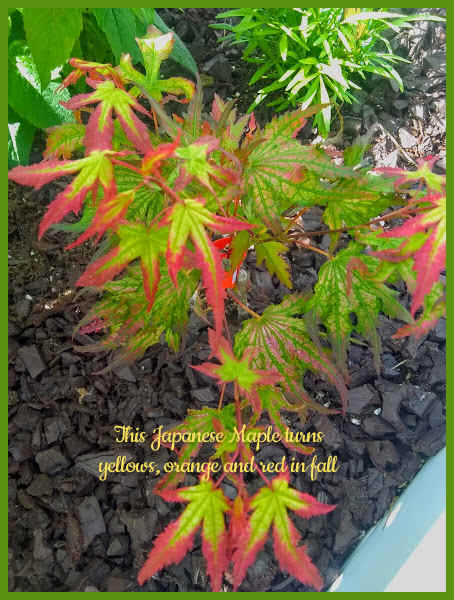 |
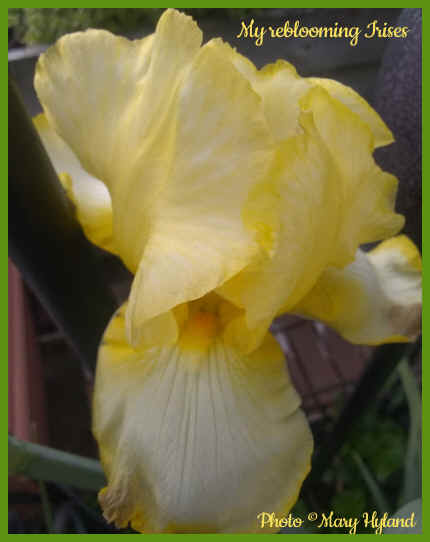 |
|
|
|
|
|
List of Fall Bloomers You'll
Love
Alstroemeria, commonly called the Peruvian lily or lily of
the Incas.
Anemone which makes excellent cut flowers that should
last in a vase for over a week.
Aster a beautiful perennial with
yellow center and white, red, pink, purple, lavender or blue
petals.
Black-Eyed Susan should last in a vase for up to 10 days
Carnation
Chrysanthemum
Cosmos an herbaceous perennial from the sunflower family.
Gerbera Daisy florists favorite has a long vase life.
Hydrangea blooms from late spring to late autumn.
Re-blooming Iris a hardy perennial that comes
in many color combinations, including blue and purple, white and
yellow, pink and orange, cream and red, and even black.
Nerine a pink autumn flowering bulb, which will flower
for years once established. Bulbs are plantedPlant these bulbs
in spring.
Rose some of the garden varieties are perpetual bloomers
through fall.
Bittersweet a semi-woody herbaceous perennial
vine that looks wonderful in vases and window box arrangements.
Perennial Zinnia blooms from mid-summer all the way
until the first hard frost.
|
|
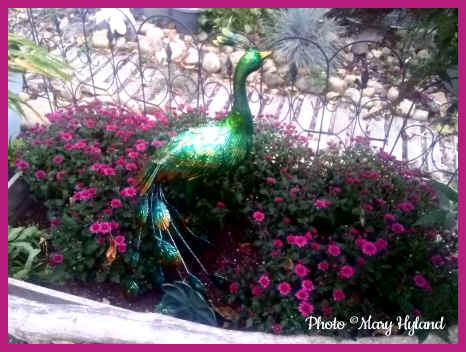
|
Easier
than another round of planting in the summer for the fall, pot up fall
plants like asters and chrysanthemums in bold and colorful pots, along
with a few leafy shrubs and small trees that boast fall color, that can
just move right in after the summer blooms are done. Get re-blooming
irises in yellows, oranges and purples. I did that and the combination
is amazing. The design of an Autumn Garden is a little different. You
would specifically design your garden to bloom in autumn, turn
particular colors, or be moveable in pots according to a design plan in
your imagination. Just think of the colors, and it will come to you
easily. The trick is to transition the new plants in pots into the empty
spaces left by the summer blooms that are going to bed for the winter.
Planting in pots keeps you from having to find space and disturbing your
other plants. Place them on plant stands and ornamental metal plant
shelves for differing heights (and you don't need to find space - go
vertical). I place several large centerpiece pots in the centers of
my elevated raised garden beds, to give them height. Most of the plants
in the raised beds go to sleep after the summer, so these pots filled
with fall flowers are instant garden-makers.
There are several
groundcovers suitable for filling in-between plants, as well. Creeping
Jenny is a bright yellow-green that creeps along and forms a mat between
plants. Not invasive at all. Jut spreading politely. The green/yellow
combo is beautiful with the oranges and reds of fall flowers and
foliage.
Chrysanthemums
come in lots of sizes and colors and they're another zero-maintenance
plant except for summer pinching to keep them bushy.
Don't forget the window boxes
and add silks - Another easy trick I use every season - and don't let
anyone look down their noses at you...... I use high quality,
weather-resistant silk flowers, berry sprigs, vines, and multi-flower
bushes. The best and most realistic-looking that I can find. In window boxes,
and in empty spaces in the garden, or where nothing much grows there. A
bowl or metal container with higher end silk flowers and foliage looks
beautiful on the tables in your seating areas, and among the flowering
plants. Do it and expand your design with class. My window boxes have
done me in every year. I can't grow a lot in the full sun in a box less
than a foot deep. And then, you have the stragglers and the ones 2
stories up that just give up the ghost. You have to keep replacing
dead things with new living things. Never the right mature size in
summer. That's when I began to decorate the gardens with a sprinkle here
and there of life-like florals in bare spots and useless corners.
The window boxes are too high and out-of-the way for folks to peer at
too closely and recognize the posers. Mine have lasted 5 or 6 years
before the harsh Pennsylvania weather killed them. I change them
out, and my outdoor decorative house flag, with the seasons. On or
off-season. If you purchase good silks, they will last a long time and
people will ask you where to get the flowers you're growing They are
worth every penny, in combination with your garden beauties.
Visit this page for ideas about growing and decorating window box
arrangements.
If you plan well, it
will be no trouble at all growing an Autumn Color Garden, and you can do
it in no time. There are many perennial foliage and evergreen plants
that are already available in those colors and shades that can be grown
all the time. They laugh at the cold weather, and return every spring
and summer, waiting for the spring and summer flowers to do their
things. Lucky gardeners will get those plants that bloom summer til
frost. A good shrub for that is white Hydrangea. It blooms it's head
off, and as it gets close to fall, it presents another array of changing
colors from white with green, to cream, to pink, til frost kills it. You
can leave the flowers on the shrub to dry, and pick them for indoor
dried flowers in the winter. Or you can pick them, pop them into a vase,
let the water naturally evaporate, and you still have beautiful dried
and intact hydrangeas to decorate your home until next spring.
Another great plant for
autumn color and textures are several varieties of sedum. The creeping
and the mid-sized produce tight bunches of succulent leaves, topped in
oranges, salmons, yellows and reds. Achillea pairs beautifully with them
with their ferny, delicate leaves and clusters of airy blooms that
attract pollinators from summer til fall. As does Bee Balm in differing
shades of reds. I have long-season daisies in yellows and white that
will re-bloom if dead-headed all summer.
Clematis and
honeysuckle in pots and climbing on fences, trellises and walls - they
add the vertical interest that most gardens heading into fall don't
have. And you can hide anything unsightly by training them up or around
it. My honeysuckle and clematis rotate their bloom times, and most
varieties of both bloom until a freeze kills them for winter. They'll be
back in spring even better than before. Orange and yellow trumpet vines
and bittersweet are very pretty on arches and pergolas if you can
control them in a pot - they are invasive otherwise. When my roses are
done blooming (some in September, others in November or so), I allow my
clematis wind it's way through the branches. They're amazing when
growing together with roses in summer, and they extend the blooming
season for you. They're very thin and delicate, so you don't have to
fight them to tug them off the rose canes if you want to.
The fall garden is a
little different that your summer garden. You won't be able to enjoy it
for very long, so place your garden where you can enjoy it. Add
decorative statuary and symbolic decor. A birdbath and feeder will bring
the birds heading south to your garden for a break. The bloom
time of some plants, like chrysanthemums, is long. But it will be too
cold to sit out there before they're done. If you can put it near one of
your windows, so that you can look at and enjoy it when it's too cold to
sit outside, you'll enjoy it more. Best place is anywhere where you'll
see and visit it during the day.
So put out a bistro table and
chair or
a rustic bench among your garden decor so that you can sip a cup of
coffee, tea, hot buttered rum or hot mulled cider during the last remaining Indian Summer days outdoors. The scent of wood burning
stoves, apple and cinnamon scented candles, and the glow of warm white
solar fairy lights are very enticing and beautiful at night. Which comes much earlier
in fall. You might even want to place a few solar coach lanterns or
fairy lights among your plants. Spend a few minutes in the evening
enjoying it while you can. The nicest thing about the fall garden is that although the plants
will die down for winter, those perennials will be back up and growing
in time to put on a beautiful show next season without missing a step.
Article ©2021 Mary
Hyland
All rights reserved.
May not be republished
|
